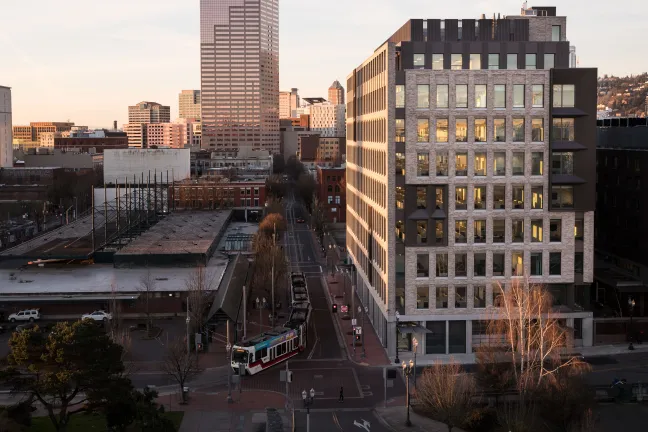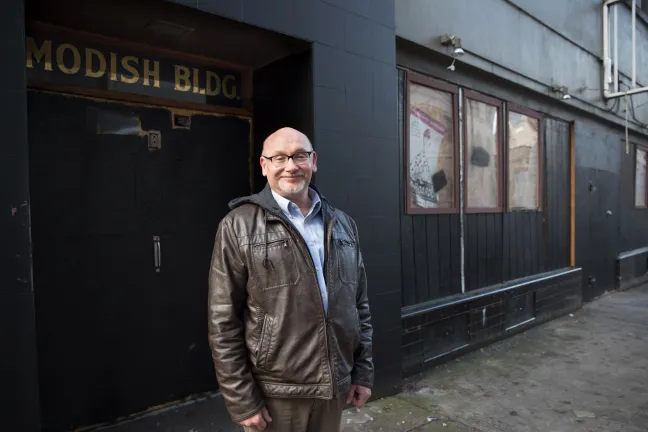In her fifth State of the County address, Multnomah County Chair Deborah Kafoury announced the launch of the region’s first mental health resource center downtown, a re-envisioning of the family shelter system, and a commitment to fair pay and diversity on public construction projects.
“What the County does every day is face the most complex and confounding problems of our time, the issues that chew people up, leave people behind and have no easy solution,” Kafoury said Friday in her annual address. But, “we’re using our values, our lived experience and our tireless dedication to do what’s right.”
Kafoury outlined how the County has updated its infrastructure and modernized its systems. She also detailed the County’s work to improve public health and the commitments it has kept to lift up equity and opportunity. [
She spoke at the City Club of Portland’s Friday Forum before a crowded ballroom that included County employees and community partners, advocates and elected officials.
Newly elected Commissioner Susheela Jayapal sat alongside civil rights advocate Kathleen Saadat and Marcus Mundy, director of the Coalition of Communities of Color. Commissioner Jessica Vega Pederson invited grassroots organizer Tony DeFalco and Rep. Diego Hernandez, D-Portland. Commissioner Lori Stegmann sat with leaders from east Multnomah County communities, including Gresham Mayor Shane Bemis and Wood Village Mayor Scott Harden. Kafoury’s invited guests included mental health advocates and peer leaders Kevin Fitts and O'Nesha Cochran, while Multnomah County’s Office for Sustainability welcomed Neighbors for Clean Air co-founder Mary Peveto. Commissioner Sharon Meieran sat with her District One team, which conducted an exhaustive analysis of the region’s mental health system
The County’s mandate as a safety net for the most vulnerable took root in 1855, when the first Board of Commissioners were asked to help a neighbor experiencing homelessness and mental illness, Kafoury said. The County covered the cost of his lodging and care — $0.63 per day.
“That is our history. That is our mission. And that is why I am here,” Kafoury said. “To stand at the intersection of service and justice and face seemingly impossible crises head on.”
A Climate Crisis
No crisis is more sweeping than climate change.
Kafoury said since she took office, the County has seen hotter, drier summers fuel wildfires and worsening air quality. Changes in snowpack and early snowmelts threaten water resources. Those changes endanger community members’ health, driving up emergency room visits from heat exposure and air pollution, tick-borne illnesses and algae blooms.
Despite a state commitment to greenhouse gas reductions, Oregon’s emissions have continue to climb since 1990. The County adopted a Climate Action Plan, in partnership with the City of Portland, and despite all the growth the region has experienced, has actually seen emissions decrease 21 percent.
Last year the County and City of Portland vowed to move to move to all-renewable energy for the community’s electricity needs. By simply shifting the County fleet and buildings to renewable energy, the County has cut emissions more than 57 percent.
The County also passed rules to curb diesel pollution from old engines on publicly funded construction projects and adopted a wood smoke ordinance to improve wintertime air quality.
“Scientists tell us we have 12 years to dramatically cut emissions before the worst impacts of climate change are locked in,” Kafoury said Friday. “My daughter Anna just turned 13. And I can tell you, those years passed in a flash.”
Treatment beds. Not jail beds.
Another threat faces our families — one that kills in minutes, not decades.
The nation’s opioid epidemic has hit Multnomah County hard. About 1,000 people show up at emergency departments following a drug overdose. Central City Concern estimates 2,500 people show up at its Hooper Detox center each year seeking treatment. And 10,000 more people who need drug and alcohol treatment land in County jails.
“The sad fact is we desperately need more state and federal money to get more people into treatment,” Kafoury said. “But while we keep hammering away in Salem and in Washington, D.C., we also keep acting locally.”
The County’s health system changed its prescription guidelines; in just four years, dentists at County clinics cut opioid prescriptions by 80 percent.
The County also leads a regional partnership to provide safer places to dispose of syringes instead of County streets.
And last year the County joined a growing field of local governments, tribes and states that have sued the pharmaceutical companies that aggressively marketed addictive prescription drugs. That case, now with more than 1,500 plaintiffs, is scheduled for trial this fall.
The Sheriff’s and District Attorney’s offices have teamed up to lead jail diversion work that redirects people facing low-level drug charges to treatment.
Beyond tackling the roots of addiction, instead of its symptoms, diversion also offers an opportunity to address the racial disparities that permeate the criminal justice system.
“We all know that jail is the most expensive and least effective place to house someone with an untreated mental health or substance use disorder,” she said.
The County has worked for years to reduce the over-incarceration of people of color. African Americans make up about six percent of the County’s population, but 20 percent of the jail population. A new program opened this week to divert some of those individuals from a justice system ill-equipped to support them.
The Diane Wade House is a transitional housing program designed for Black women and run by Black women.
“We are still jailing too many people whose behavior is driven by unmet behavioral health needs,” Kafoury said, “and we are still jailing too many people of color.”
“Once-in-a-lifetime projects”
This month, 500 Health Department employees are moving from a re-purposed 1923 department store to a nine-story building constructed especially for them and their work — complete with a first-floor pharmacy, upper levels with private exam rooms, and open spaces that accommodate a central laboratory.
It has also been built to current seismic codes.
“What always worried me was that if we ever had a public health emergency,” Kafoury said, “the command post was housed on the 10th floor of that physically challenged building.”
Like the Sellwood Bridge before it, the new Gladys McCoy Health Department Headquarters came in on time and on budget. It will soon be joined by a seismically safe 17-story central courthouse, slated to open next year.
“These are once-in-a-lifetime projects,” Kafoury said. “We’ve invested more than $750 million in new construction in this community, creating beacons of health, safety and justice.”
And the County isn’t done. Two years ago the Board approved a vision to modernize county libraries; they expect to see a technology and infrastructure proposal later this year.
Up to speed
It’s not just public spaces that needed a facelift. The county invested almost $42 million to overhaul its antiquated business and contracting operations. The effort, called MultCo Align, modernized everything from payroll to purchasing.
Every year the County issues more than 1,000 contracts, worth more than $260 million.
“Before this change, employees managed these contracts by hand, using the phone, email — and, yes, sticky notes — to track, edit and get approvals,” Kafoury said.
The shift will help the County continue practices that have won accolades for its fiscal responsibility. This year it again earned the highest possible AAA bond rating from S & P Global Ratings and Moody’s. The County also received a clean audit from external auditor Moss Adams and — for a 34th consecutive year — an Excellence in Financial Reporting award from the Government Financial Officers’ Association for the 34th straight year.
“That’s a commitment to excellence,’’ Kafoury said.
County Human Services has also turned to technology to improve care. A new database allows service providers to identify clients who, because of age or disability, would be more vulnerable in an emergency. They new system allowed the county to quickly reach 197 clients affected by a water main break last month and 2,500 people who needed to evacuate last year because of a scrap yard fire in Cully.
United with Workers
With those more than 1,000 contracts, and millions of dollars invested in new infrastructure, Kafoury said it was imperative to protect the people doing the work, as well.
Union members, day laborers and others have brought issues to her that people were for private companies report wage theft remains common on construction sites, through misclassified jobs or misreported timesheets.
“Today I’m announcing a new Fair Pay Initiative to prevent wage theft on County construction sites,” Kafoury said.
The County will partner with firms to offer technical assistance and train volunteers to help verify certified payroll. It’s one way the County is working to support a growing and diverse workforce.
On the Courthouse and Health Department projects, labor agreements stipulated a percentage of jobs be held for women and people of color. That brought up apprenticeship hours and ensured that on the Health Headquarters, more than one-in-four contractors and subcontractors were women, minority, emerging or disabled veteran-owned businesses.
“Technology and physical infrastructure matters, but our people matter more,” Kafoury said. “Our hiring and promotion practices matter. Our training and accountability for our managers matter.”
Nowhere has the need for accountability been more glaring than within Multnomah County government itself. For more than a year the County has heard employees’ personal stories of discrimination and racism on the job. Data showed clear disparities in how promotions were awarded and how terminations were handed down.
Working with employees of color, managers of color, and employees with disabilities, veterans or older employees, the County launched a Workforce Equity Initiative, hired a national consultant and adopted recommendations for change. Kafoury on Friday announced the County would launch an independent unit to manage discrimination complaints and is designing a new training, coaching and evaluation structure for the County’s 800 managers.
The County has tried hard to attract a diverse workforce, Kafoury said.
“But we haven’t addressed the underlying institutional racism and inequities on which this organization and our entire nation was built,” she said. “Systems designed by white people to benefit white people — like me.”
Beyond shelter beds
Since winning election as Chair in 2014, Kafoury has returned again and again to the most fundamental truth in health and human services — stability, recovery and well-being aren’t possible without a home.
She spearheaded a new County partnerships, A Home for Everyone and the Joint Office of Homeless Services with the City of Portland, to coordinate homeless services and invest in supportive housing.
She championed and invested in an expansion of temporary shelters and short-term rental assistance. The number of people sheltered and returned to housing is now double what it was four years ago.
But affordable housing remains in short supply, challenging that progress. Across the region, 56,000 households pay so much in rent that any unexpected bill or accident could result in them losing their home. Wait lists for federal housing assistance are long. Immediate solutions have meant opening warming shelters, winter shelters, and 24-hour shelters to accommodate families. And as shelter stays grow longer than ever, Kafoury said, children don’t thrive when they share a noisy hall with 120 other people.
Until a family can have a home of their own, they should at least be afforded personal space. This year the family shelter system will transform itself so that every family has access to a personal, secure room. In June, a shelter for 40 families called Lilac Meadows will open in a master-leased motel and offer a range of amenities and on-site social services.
The County, through the Joint Office, is also supporting a new family shelter in Lents that provides personal spaces for 25 families until they can transition to permanent housing.
That commitment to improving shelter goes beyond the family system. Also this summer, a long-planned shelter for 120 women and people in couples will open on SE Foster Road. It will include not just beds and laundry, but also classrooms, a kitchen, computers, health services and case managers.
“We came together in a crisis but that crisis isn’t over,” Kafoury said, citing the high rents that are pushing people onto the County’s streets and then making it more expensive than ever to help them back into housing.
“That’s a razor’s edge that can turn a single missed paycheck or illness into catastrophe,” she said.
Even with the County’s work to add affordable housing, expand and improve shelter, and provide transitional housing, a significant gap remained downtown. There was no resource center for people in a mental health crisis.
When a person experiencing homelessness leaves the Unity Center for Behavioral Health, or, is discharged from an emergency department or released from jail, they often have nowhere to go but the street. And the cycle begins again.
That will soon change, Kafoury said, as she announced the purchase of the Bushong building downtown building where the County will work with peer support groups to provide mental health resources, a and transitional housing.
“They will get the kind of help we have never before been able to offer, and that’s a pretty awesome thing,” she said.
It’s the brainchild of Mental Health and Addiction Services Division supervisor Neal Rotman, who researched similar programs for years and proposed this project with support from peer advocates.
“I know a better world is possible because, every day, I watch 6,000 County employees face the most complex and serious problems of our time with courage, creativity and heart,” Kafoury said. “It is an honor to serve with you.”





